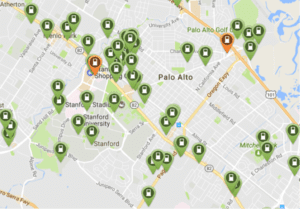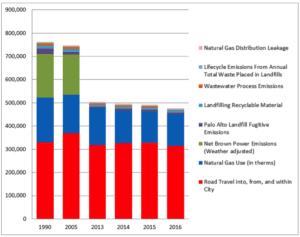
Expanding electric vehicle charging infrastructure in Palo Alto
By expanding the charging infrastructure through rebates for charging stations, Palo Alto is promoting the use of electric vehicles.
Over the past decade, the United States has experienced consistent growth in electric vehicle (EV) sales and deployment of EV charging stations. This growth has been particularly notable in California. For example, 15% of new cars purchased in Palo Alto in 2015 were electric. By 2020, the City of Palo Alto expects upwards of 10,000 electric vehicles to be on the road – a sizeable number in a city with only 67,000 residents. While the electrification of transportation can drive significant reductions in greenhouse gas emissions, it is no simple task. Managing the efficient integration of EVs and necessary charging infrastructure requires thoughtful planning and execution.
Palo Alto already has more EV charging stations than most comparably sized cities; however, the anticipated growth of EVs means many more will be required in the near future. Currently, the city owns and operates 40 charging ports and plans to double that number over the next year. A majority of these charging stations are Level 2 (240 volt) chargers, which charge at a rate of 20-25 miles per hour depending on the EV model.

To encourage the rapid expansion of EV infrastructure, the City of Palo Alto Utilities offers generous rebates to nonprofits, schools, and multi-family complexes to install charging stations. Funding for these EV charger rebates comes from the sale of Low Carbon Fuel Standard (LCFS) credits at the state level. Administered by the California Air Resources Board, LCFS funds are generated by fees levied on high-carbon fuel producers, such as oil refineries. Funds are then given to low-carbon fuel generators such as the City of Palo Alto Utilities, and a portion is distributed as rebates for EV charging stations.
The goal of the LCFS credit program is to lower the carbon content of fuels in California. This program is similar to the California Air Resources Board’s Cap-and-Trade Program, a market-based approach to controlling greenhouse gas emissions by providing economic incentives for achieving reductions. Both programs seek to drive down greenhouse gas emissions in the state, and switching from fossil fuels to renewable-based electricity in the transportation sector is a key method for reducing emissions.
As the number of EVs in Palo Alto grows, the City of Palo Alto Utilities is managing their integration onto the grid in two ways. First, the utility’s rebate program incentivizes installation of EV charging stations. Second, the utility is piloting a program to offer EV owners lower rates on their bill depending on what time they charge their vehicles. For instance, to charge during off-peak hours is much more economical for customers as opposed to charging when electricity demand is high.
Palo Alto has also made great strides in moving to a carbon neutral electric portfolio. The next step in reducing the city’s carbon footprint is to transform its transportation sector. As shown in the chart below, two-thirds of Palo Alto’s carbon emissions come from automobiles.

For Palo Alto to achieve its ambitious goal of reducing greenhouse gas emissions 80% below 1990 levels by 2030, widespread deployment of EVs is essential. Every fossil fuel vehicle that is traded in for an EV is estimated to reduce greenhouse gas emissions by approximately 3.5 tons/year. AssumingPalo Alto will have between 3,000 and 10,000 EVs by 2020, emissions related to automobile use could be reduced by 9%, and the city’s overall emissions could be reduced 6%. The electrification of transportation, in conjunction with other transportation mode shift strategies, can significantly drive down Palo Alto’s greenhouse gas emissions.
The City of Palo Alto is taking an effective approach to increasing use of EVs. By focusing on expanding the charging infrastructure through rebates for charging stations, Palo Alto is going above and beyond by providing an EV charger rebate on top of the California state rebate and federal tax credit for purchased EVs. With this strategy, the city is accelerating the fuel-switch in the transportation sector and clearing the way to a clean energy future.
The City of Palo Alto is a city in the Peninsula Advanced Energy Community (PAEC) region. PAEC is a groundbreaking initiative to streamline policies and showcase projects that facilitate local renewables and other advanced energy solutions like energy efficiency, energy storage, and electric vehicle charging infrastructure. PAEC will create pathways to cost-effective clean local energy and community resilience throughout San Mateo County and the City of Palo Alto; and beyond. The PAEC is a collaboration between the Clean Coalition, the California Energy Commission, Pacific Gas and Electric, and an array of municipalities, emergency response jurisdictions, schools and universities, and corporate entities. For more information, please visitwww.clean-coalition.org/PAEC.

